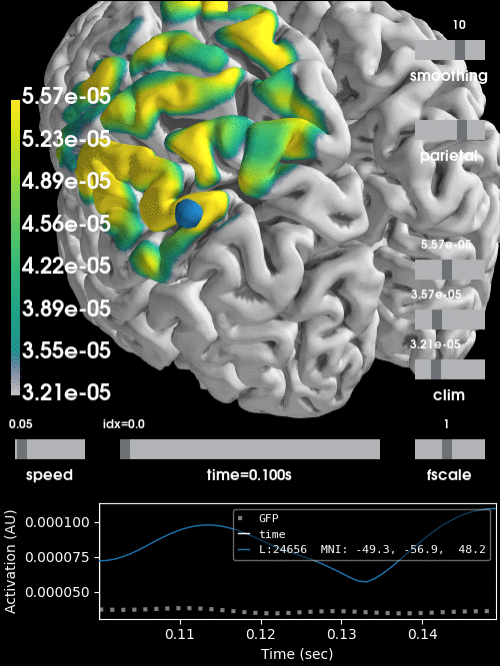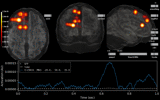mne.stc_near_sensors¶
-
mne.stc_near_sensors(evoked, trans, subject, distance=0.01, mode='sum', project=True, subjects_dir=None, src=None, verbose=None)[source]¶ Create a STC from ECoG and sEEG sensor data.
- Parameters
- evokedinstance of
Evoked The evoked data. Must contain ECoG, or sEEG channels.
- trans
str|dict| instance ofTransform|None If str, the path to the head<->MRI transform
*-trans.fiffile produced during coregistration. Can also be'fsaverage'to use the built-in fsaverage transformation. If trans is None, an identity matrix is assumed.Changed in version 0.19: Support for ‘fsaverage’ argument.
- subject
str The subject name.
- distance
float Distance (m) defining the activation “ball” of the sensor.
- mode
str Can be “sum” to do a linear sum of weights, “nearest” to use only the weight of the nearest sensor, or “zero” to use a zero-order hold. See Notes.
- projectbool
If True, project the electrodes to the nearest
'pialsurface vertex before computing distances. Only used when doing a surface projection.- subjects_dir
str|None The path to the FreeSurfer subjects reconstructions. It corresponds to FreeSurfer environment variable
SUBJECTS_DIR.- srcinstance of
SourceSpaces The source space.
Warning
If a surface source space is used, make sure that
surf='pial'was used during construction.- verbosebool,
str,int, orNone If not None, override default verbose level (see
mne.verbose()and Logging documentation for more). If used, it should be passed as a keyword-argument only.
- evokedinstance of
- Returns
- stcinstance of
SourceEstimate The surface source estimate. If src is None, a surface source estimate will be produced, and the number of vertices will equal the number of pial-surface vertices that were close enough to the sensors to take on a non-zero volue. If src is not None, a surface, volume, or mixed source estimate will be produced (depending on the kind of source space passed) and the vertices will match those of src (i.e., there may be me many all-zero values in stc.data).
- stcinstance of
Notes
For surface projections, this function projects the ECoG sensors to the pial surface (if
project), then the activation at each pial surface vertex is given by the mode:'sum'Activation is the sum across each sensor weighted by the fractional
distancefrom each sensor. A sensor with zero distance gets weight 1 and a sensor atdistancemeters away (or larger) gets weight 0. Ifdistanceis less than the distance between any two electrodes, this will be the same as'nearest'.
'weighted'Same as
'sum'except that only the nearest electrode is used, rather than summing across electrodes within thedistanceradius. As as'nearest'for vertices with distance zero to the projected sensor.
'nearest'The value is given by the value of the nearest sensor, up to a
distance(beyond which it is zero).
If creating a Volume STC,
srcmust be passed in, and this function will project sEEG sensors to nearby surrounding vertices. Then the activation at each volume vertex is given by the mode in the same way as ECoG surface projections.New in version 0.22.

